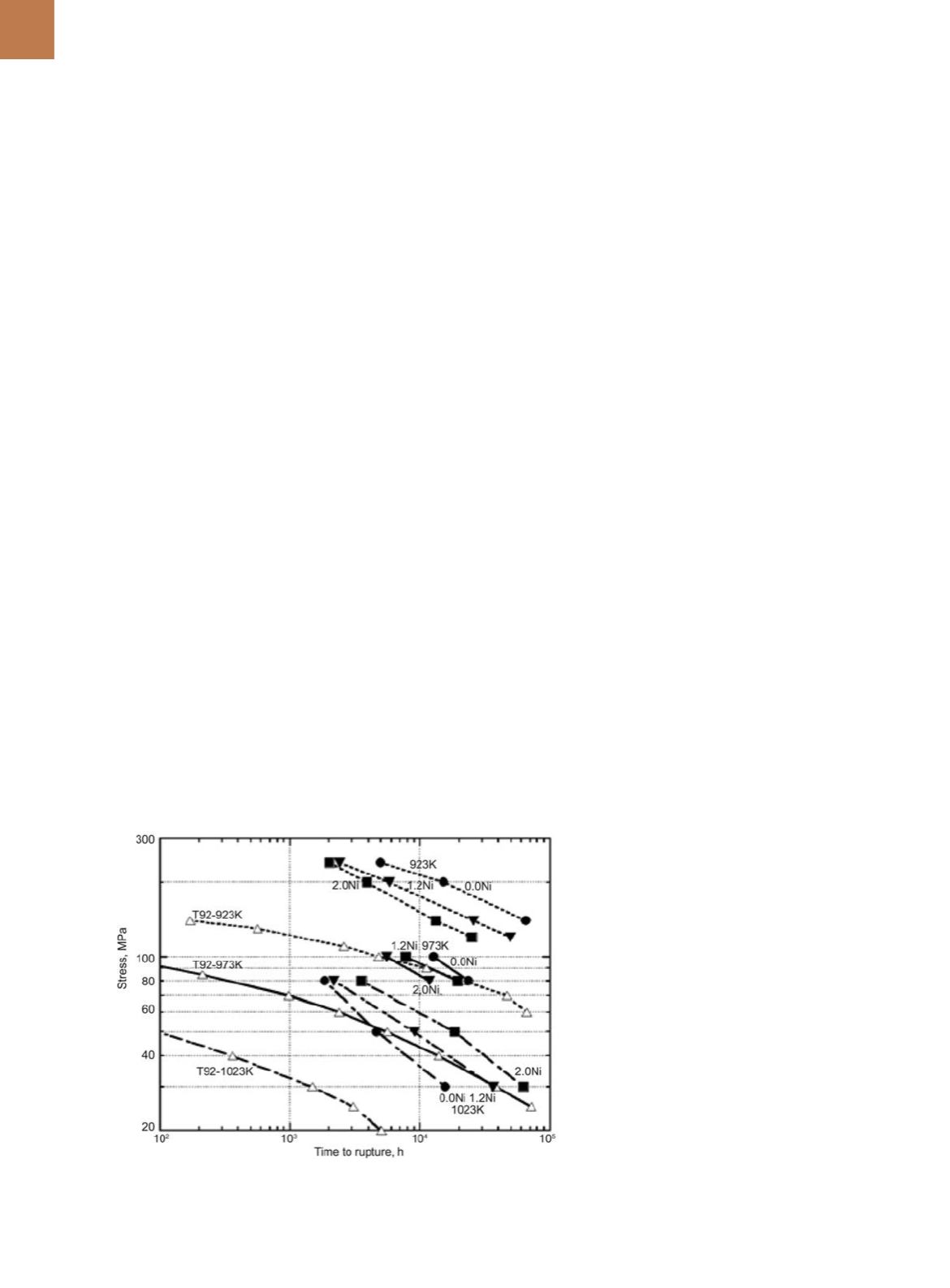

A D V A N C E D M A T E R I A L S & P R O C E S S E S | M A R C H 2 0 1 5
2 6
than fatigue-creep interactions. Never-
theless, the creep-fatigue resistance of
different material classes scales with
their known response to temperature.
The creep-fatigue crack initiation en-
durance limit for NiCr23Co12Mo (solid
solution strengthened nickel-base al-
loy) at 700°C is similar to that for 9% to
11% Cr steels at 600°C and 1CrMoV steel
at 550°C. The development of materials
with improved elevated temperature
strength may be a first step toward the
development of creep-fatigue-resistant
materials.
NEW MATERIALS
Six invited talks and seven poster
presentations comprised the “new ma-
terials” category, including seven on
bainitic, ferritic-martensitic (F-M), and
ferritic steels, four on austenitic stain-
less steels, and two on Ni-base alloys.
Alloy development trends in the area
of high-temperature structural mate-
rials for power generation systems can
be grouped into three main catego-
ries: Strength improvement of 9-12Cr
F-M steels; higher Cr ferritic steels
strengthened by stable intermetallic
compounds; and newly developed high
Cr-high Ni austenitic stainless steels
with the unique capability of either
high-temperature strength or oxidation
resistance. Most new alloy development
activities focus on Fe-base materials
rather than Ni-base, as cost-effective-
ness is one of the main drivers of mate-
rial down-selection for applications in
power generation systems.
Unique alloy design strategies were
presented that use different types of
second-phase precipitates for strength-
ening: Cr(V,Nb)N-type Z-phase in F-M
steels, Fe
2
W-type Laves phases in high
Cr ferritic steels, and
σ
-FeCr-phase and
Fe
2
Nb-type Laves phases in austenitic
stainless steels. These second-phase
precipitates were recognized as “poi-
sons” for long-termcreep properties due
to their detrimental effects, e.g., promot-
ing decomposition of strengthening na-
noscale carbonitrides and decreasing
toughness and creep ductility due to
their brittle nature. However, research
proves their effective use for improving
creep properties through proper alloy-
ing additions, thermomechanical treat-
ments, and microstructure control.
Computational thermodynamics also
play an important role in the design of
such steel alloys.
An example of improved creep
properties in high Cr ferritic steels
strengthened by Laves-phase pre-
cipitation (Toda, et al.
[1]
) is shown in
Fig. 3, which demonstrates much lon-
ger creep-rupture life of the developed
steels than that of T92 (9Cr-2W F-M
steel). Because ferritic steels are funda-
mentally free from Type IV failure issues
(premature creep failure at the HAZ)
found in F-M steels and offer advantag-
es in thermomechanical fatigue life in
comparison to all other material types,
such alloy design strategies hold prom-
ise for next-generation high-tempera-
ture structural materials. Development
of alumina-forming austenitic stainless
steels was also presented by one of the
authors (Yamamoto, et al.
[1]
), who pro-
posed a unique approach to provide a
promising oxidation-resistance via pro-
tective, external alumina scale instead
of using conventional chromia scales on
commercially available stainless steels.
GAS TURBINES
With regard to coatings, new ma-
terials that can overcome the tempera-
ture limit (1200°C) of partially stabilized
zirconia (YSZ) have been researched for
several decades. Gadolinium zirconate
(GZO) coatings fabricated on top of a bot-
tom layer of YSZ (Fig. 4) are among the
options investigated. GZO coatings fea-
ture improved temperature capabilities,
but do not possess the mechanical re-
sistance of YSZ coatings. However, newly
reported double-layer designs overcome
this limitation and show increased spall-
ation lifetime in thermal cycle testing.
Lifetime simulation procedures and test
method development for double-layer
coatings were also reported.
SUMMARY
The 10th Liège Conference on Ma-
terials for Advanced Power Engineering
continues the long-standing tradition
of collaborative European materials re-
search. Environmental concerns, flexi-
ble operation, and energy security are
global issues that necessitate high-
temperature materials development.
The authors were honored to participate
and present some recent U.S. efforts in
the spirit of strengthening worldwide
collaboration.
References
1.
Proceedings of the 10th Liège
Conference: Materials for Advanced
Power Engineering 2014,
J. Lecomte-
Beckers, O. Dedry, J. Oakey, and B.
Kuhn (Eds.), ISBN 978-3-95806-000-5,
ISSN 1866-1793.
www.fz-juelich.de/zb/ openaccess,September 2014.
Fig. 3 —
Creep stress vs. time to rupture curves for 15Cr ferritic steels without Ni (solid circles),
with 1.2%Ni (solid triangles), and 2.0%Ni (solid squares), developed by Toda, et al. Data of
conventional T92 steel (open triangles) are plotted for comparison
[1]
.


















